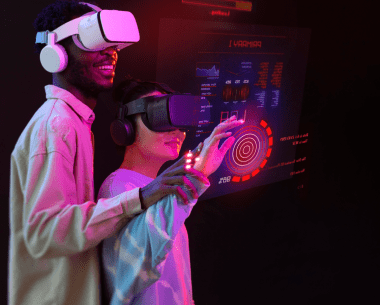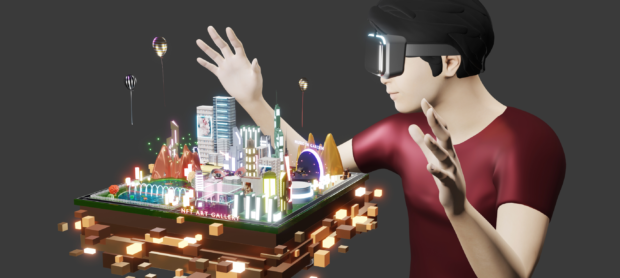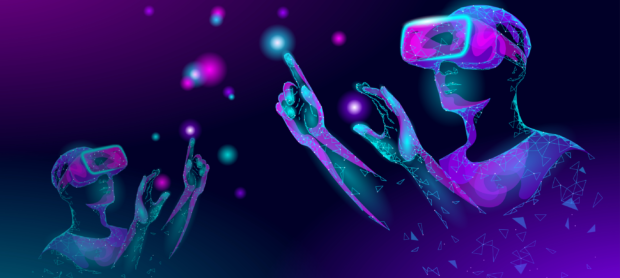At its foundation, virtual reality is an immersive technology that provides a three-dimensional, digital environment that users can explore and engage with in real time. Due to major developments in computer power, graphic rendering, and motion-tracking technologies, virtual reality (VR), which originated from the combined vision of tech pioneers in the late 20th century, has steadily grown from a theoretical concept to a practical, revolutionary tool.
In a variety of industries, including but not limited to gaming, education, healthcare, real estate, and most importantly enterprise solutions, the use of VR has increased tremendously. Businesses are using virtual reality (VR) more often to transform previously abstract notions into interactive, immersive experiences. These activities range from consumer interaction and business meetings to staff training and product design.
Understanding VR Application Development
Understanding the fundamentals of VR application development is the first step in starting a trip there. The building of an artificial world that completely immerses the user and tricks the mind into thinking they are somewhere they are not is at the core of VR development. Combining 3D computer visuals, real-time gaming engines, specialized input devices, and sensory feedback, an immersive experience is created.
The degree of immersion is one of the core ideas in VR, and it differs between various kinds of VR applications. Users who utilize non-immersive VR can engage in a virtual environment without being fully cut off from the actual world. This type of VR is frequently seen in desktop apps or video games.
A bigger display and more intricate tracking systems are often used in semi-immersive VR, which offers a higher level of immersion and is widely used in simulations or educational settings. The most captivating VR experience, fully immersive VR, often uses a head-mounted display (HMD) and input sensors that detect movement in various directions to create an all-encompassing virtual reality.
The development process and the user’s experience are both strongly influenced by the choice of VR hardware and platforms. The Oculus Rift, renowned for its high-resolution display and integrated audio system; the HTC Vive, well-known for its precise tracking system; and the PlayStation VR, well-known for its seamless connection with the PlayStation game environment, are among the gadgets at the forefront of the VR revolution. Each device has distinct capabilities and limitations, necessitating careful attention throughout the creation of the application.


Steps to Develop a VR Application
Pre-production, production, and post-production are the three primary stages that make up the creation of a VR application.
1. Pre-production
Concept development, the initial process, is generating and honing the idea for your VR application. What issue does it address? What special opportunities does it provide? You must respond to inquiries of this nature at this time. Next, deciding who your target market is essential since it affects the look and feel of your VR application. The comfort, security, and pleasure of different audiences should be a top consideration because they have different levels of experience with VR. Finally, it’s critical to choose the appropriate VR platform. Your target audience, the intended level of immersion, your financial limitations, and the particular hardware capabilities you wish to use should all be taken into consideration while making this choice.
2. Production
The real development of the VR application takes place during the manufacturing phase. Developing 3D models and environments, writing the application logic, scripting the user interface and user experience (UI/UX), and producing immersive audio effects are all included in this. During this stage, familiarity with VR programming tools like Unity or Unreal Engine is crucial.
3. Post-production
After the application has been created, thorough testing is required. This includes testing the program for problems, making sure it functions properly on the desired VR platform, and ensuring that it offers a pleasant and interesting user experience.
The VR application can be started after testing. To guarantee that your application reaches its target audience and stands out in the fiercely competitive VR industry, effective marketing methods should be used.
Necessary Tools and Skills for VR Application Development
A variety of technologies and expertise are needed for the interdisciplinary area of VR application development. Here, we’ll focus on some of the most important programs and abilities that can position you for success in this fascinating field.
Applications and Tools
Unity and Unreal Engine are two of the most often utilized game engines in VR creation. These potent platforms give users the resources they need to build interactive, immersive 3D experiences.
Both novices and experts use Unity because of its user-friendly interface and thorough documentation. It is a flexible option for VR development due to its support for a variety of VR devices and capacity for C# scripting.
Unreal Engine, on the other hand, distinguishes out because of its realistic graphics and powerful physics engine. It makes it possible to create games without writing a single line of code thanks to a visual scripting framework called Blueprints. However, knowledge of C++ is required for more advanced functions.
Other useful tools include audio editing software like Audacity, texturing applications like Substance Painter, and 3D modeling software like Blender or Maya.

Important Traits for VR Developers
For VR creation, a solid programming base is essential. Commonly utilized in Unity and Unreal Engine, respectively, are languages like C# and C++.
For the purpose of producing components for the VR environment, 3D modeling expertise is also necessary. It helps to be familiar with programs like Blender or Maya.
Your VR application’s realism and interaction may be greatly improved by having a solid understanding of AI. AI is a key component in many VR experiences, from producing intelligent NPCs (Non-Player Characters) to inventing cutting-edge gaming dynamics.
One must also have a solid understanding of UX/UI design principles. In VR, user experience includes more than just on-screen user interfaces; it also includes interaction design, sound design, and spatial design. To avoid user confusion or motion sickness, it’s critical to develop intuitive and cozy experiences.
The Role of VR in Future Enterprises
Virtual reality (VR) is expected to have a transformational and expanded role in business in the future. Businesses from a variety of industries are ready to take advantage of VR’s potential to promote efficiency, creativity, and consumer engagement as technology continues to advance.
Future developments in VR technology suggest ever more realistic and immersive experiences. VR worlds will soon be impossible to tell apart from the actual world because of developments in graphic rendering, haptic feedback, and AI. Incorporating biometric technology, like eye-tracking and brain-computer interfaces, may lead to the development of more user-friendly VR interaction techniques.
Additionally, it is anticipated that the integration of VR with other cutting-edge technologies like 5G, the Internet of Things, and blockchain would bring up both new opportunities and difficulties. Real-time cooperation in virtual worlds, for instance, might be made possible by the combination of VR with 5G, transforming distant work and education. Similar to this, the integration of VR with IoT may enable previously unheard-of levels of data interaction and visualization across several markets, including industrial, healthcare, retail, and entertainment.

Final Thoughts
In conclusion, Virtual Reality (VR) is set to revolutionize business operations as the cutting edge of technology advancement. VR technology has developed from a specialized idea to a game-changing tool, as we’ve covered in this book, with applications spanning a variety of industries, from gaming and education to healthcare and business solutions.
The use of VR in organizations seems to have a bright future, since technological improvements are expected to fundamentally alter how companies conduct their operations. The engaging experiences that virtual reality (VR) can offer can change how we approach training, product creation, and consumer engagement tactics.
We advise businesses to think about incorporating VR into their business plans as we approach this new era. The path could be difficult, but the rewards might be enormous. And you don’t have to travel on this adventure by yourself.
We at Eventyr are enthusiastic about making your ideas come to life. We can assist in turning your virtual reality (VR) concept into a concrete reality with a highly skilled professional team working under your direction. Whether you’re a seasoned expert or a curious newcomer, we’re here to help you at every turn. So don’t wait, contact us right now and let’s together develop the future of VR.




